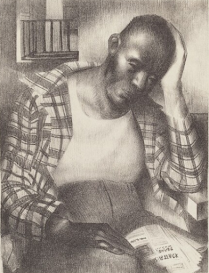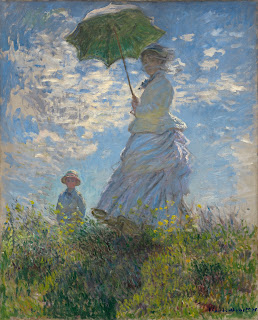Modern Art
The Great Depression
"The Great Depression was the worst economic downturn in the history of the industrialized world, lasting from 1929 to 1939. It began after the stock market crash of October 1929, which sent Wall Street into a panic and wiped out millions of investors. Over the next several years, consumer spending and investment dropped, causing steep declines in industrial output and employment as failing companies laid off workers." This time was extremely challenging for many individuals as they were struggling to make ends meet. This ultimately led to failed banks and a loss of consumer confidence. The effects of the stock market crash were perpetuated by the loss of consumer confidence, making The Great Depression last ten years.
The Pensive Man
This was one of the many art pieces created during the great depression. Many artists found relief in expressing themselves through art. This specific art piece was created by Seymour Fogel in 1936. The exact location where this piece was painted is unknown but many believe it was in the Midwest. In this painting, you can see that this man looks like he is going through tough times. He is holding his face in his hand as he looks down at the newspaper. In the newspaper, the word "attack" appears, this may be what is causing this man distress. To me, it seems as though he just got off of work after a long day because he still has his top on but he unbuttoned it, this also gives me the feeling of carelessness. The corners of his lips are slightly pointing down and his eyebrows are somewhat furrowed. "Fogel was like many other artists that created works that the government commissioned to keep art alive during the depression. This piece depicts that day-to-day life was miserable for Americans." All in all, this painting represents a man in distress that feels all alone. You can see that the Great Depression influenced art during 1929 and 1939 because the difficulties that impacted many lives were seen in the art that was being created. I would not want to own this art piece because it captures a man who is overwhelmed and stressed due to the impact of The Great Depression. Being that I am in the military, I find myself stressed enough, I do not want something that would remind me of my stressors.
Automat
This painting is overall very different than the last one. This painting captures "an early kind of self-service restaurant that offered cheap food to eat in a cafeteria or to take away. Patrons inserted coins next to a window containing their choice of food, and the door unlocked, permitting them to remove it." This was created in 1935 by Berenice Abbott. Instead of capturing the struggles of this period, she focused on innovation. Automats allowed people access to fast, cheap food. This was specifically important during this period because individuals were out of jobs or weren't making much money if they did have a job. "In 1935, Berenice Abbott proposed and directed a project for the WPA’s Federal Art Project called “Changing New York.” Her ambition was to photo-document New York City, which was rapidly modernizing with skyscrapers; new, often WPA-funded infrastructure such as subway lines, bridges, and tunnels; and novel types of shops and conveniences, such as this automat. " The Great Depression affected art during the Early Modern Art Era because people were able to raise awareness through their artwork. This is a pretty cool painting but I wouldn't necessarily want to own it because it does not spark my interest.
The Great Bootleg Coal Industry
This painting by Elizabeth Olds from 1936 represents what individuals had to go to get be during The Great Depression. "After a day’s work, coal miners in Pennsylvania and elsewhere would often “glean” coal for personal use—with the tacit permission of mine managers. However, worker layoffs during the Depression due to decreased demand for coal and the automation of coal mining led to a huge increase in bootleg—or illegal—mining practices. Laid-off workers returned to mines without permission to dig or collect coal on their own and then sold the bootlegged coal on the open market. The economy of bootlegged coal became big business, with estimates of up to 100,000 people in Pennsylvania living off the practice. Oral history records one miner stating, “We ‘steal’ coal to keep from becoming thieves and hold-up men, which, to keep alive, we probably would be forced to become if we didn’t have these holes” (Louis Adamic, 'The Great Bootleg Coal Industry,' originally published in The Nation, 1934)." This art piece perfectly captures the struggles that many people faced during this time. The difficulties of this time led to individuals having to make a way for themselves any way they could. Which in this case meant not being integral. This art piece shows how The Great Depression influenced the Early Modern Art Era because it captures the things individuals had to do just to get by. I wouldn't own an art piece like this because an art piece like this simply would not complement my home. The story behind it is interesting but it is just not something I would want in my home.
Citations
History.com Editors. “Great Depression History.” History.com, A&E Television Networks, 29 Oct. 2009
Unknown. “Art and the Great Depression.” Great Depression
Unknown. “Great Depression.” Great Depression






Hello,
ReplyDeleteThe Pensive Man really caught my eye, it had a lot of emotions in there that relates to this period and the actions that were going on. Such as the great depression, just as you mentioned. I found that I was attached to the relief that shown through the pieces. During this hard time creativity comes in many forms, I enjoyed that there wasn't a solid line throughout the piece. It felt to me that it kept the illusion of floating stress free.